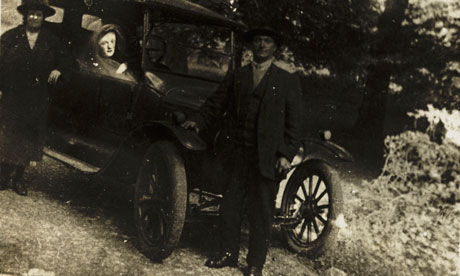
Look closely at the image above. Do you get a chill down your spine? Are the hairs standing up on the back of your neck? Cold Sweats? No? Me neither. It is a spirit photograph, taken in the 1920s by English photographer William Hope, an image which purports to show an apparition of the couple's dead son sitting at the wheel of their car. The subjects at the time took this image to be real, evidence that their son's soul lived on, proof of life after death.
Hoaxers and charlatans have been around for a lot longer than the photographic process but they certainly saw its capabilities and were early adopters of the technology. The rise of interest in spiritualism and psychic studies reached its peak in the second half of the 19th and early 20th centuries and the Bostonian engraver and amateur photographer William H Mumler was the first to take advantage of this. While developing a glass plate negative of a self-portrait in the early 1860s, Mumler discovered an accidental double-exposure of a person in the background, it was an image of his cousin who had died 12 years previously.
America was still recovering from the civil war and there were many grieving relatives of whom Mumler could take advantage, he famously produced the image of the spirit of President Abraham Lincoln appearing over the shoulder of his widow Mary. He moved to New York and set up a thriving business reportedly charging $10 for three prints. Not all people of the time were this gullible, Mumler was discredited at his trial for fraud in 1869: the legendary showman PT Barnum being the star witness for the prosecution produced his own spirit photograph that he had commissioned from a photographer to show how easy the images were to produce. Mumler was acquitted but his career as a photographer medium was ruined.
This didn't dissuade the many other spirit photographers who followed in his footsteps, Édouard Isidore Buguet is said to have produced ghostly images on an almost industrial scale from his studio in Paris in the 1870s. Buguet was not just content with spirit photographs, he even faked images of himself performing telekinesis on a chair. He was also exposed and was imprisoned for a year, the raid on his studio uncovered hundreds of props used to create his illusions.
Many other notable spirit photographers achieved fame and fortune in the years to come, fooling numerous photography experts. Frederick A Hudson, believed to be Britain's first practitioner, started in the 1870s went through elaborate rituals in front of his subjects, staggering around and moaning, pretending to be possessed by spirits before taking his photographs. He too was also exposed and was actually caught dressed up as a ghost. Hudson continued with his chicanery using a trick box camera made by a manufacturer of magical illusions, the contraption held a positive image of a ghost inside it which would be exposed on to the glass plate negative on which he would take his portraits.
William Hope continued to swindle naive subjects in the 20th century. The former carpenter made his first creation in 1905, and formed a spiritualist association, the Crewe Circle in his home town.
Hope utilised technological advancements by improving the quality of his double or even triple-exposures. He exploited grieving families who lost relatives in the first world war among whom was Sir Arthur Conan Doyle, who found solace in spiritualism after the death of his wife and sons. Doyle even went as far as to pen a treatise entitled The Case for Spirit Photography in 1922 after Hope was exposed as a trickster.
Spirit photography continues to fascinate people in contemporary society, not least Steampunks with their love of eccentric Victoriana. Many collectors see these images as curiosities, but to most they are just a historic example of fake photography which is even easier to produce in the present day.

